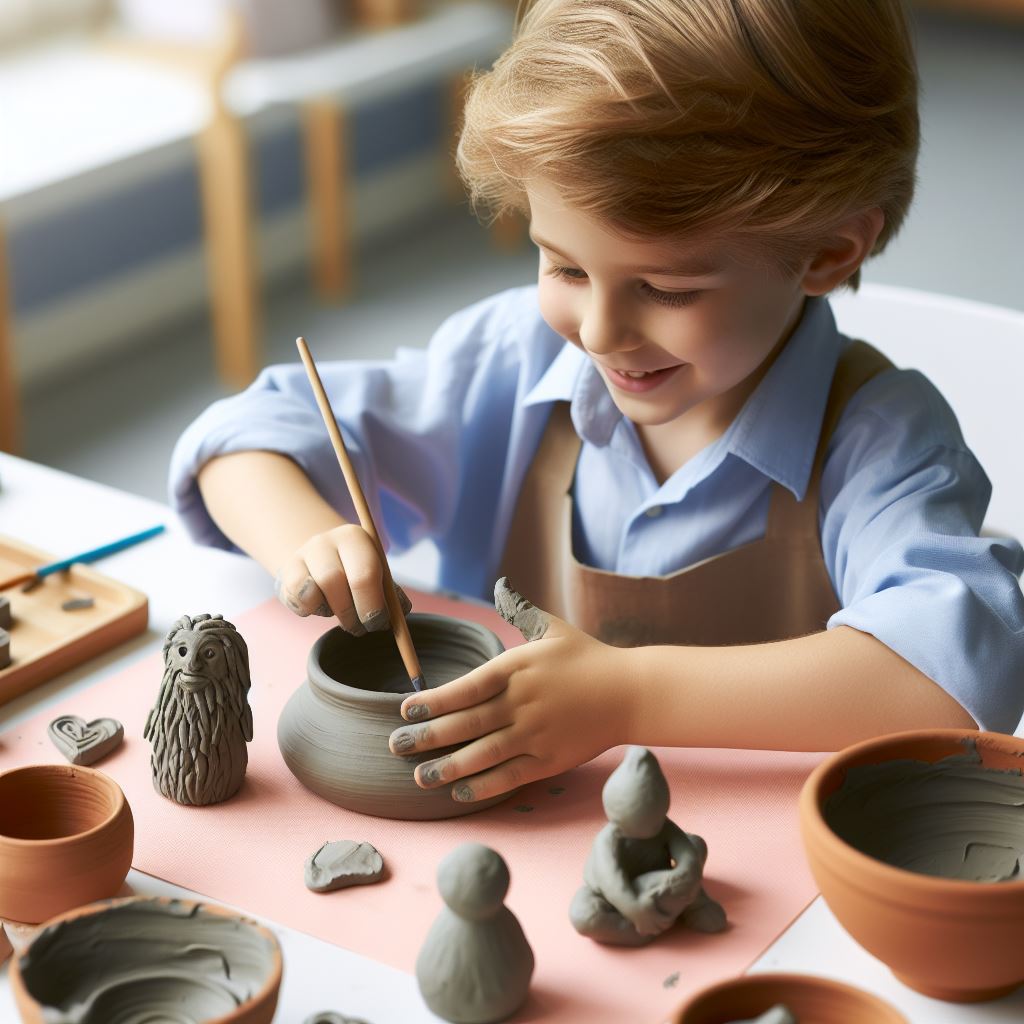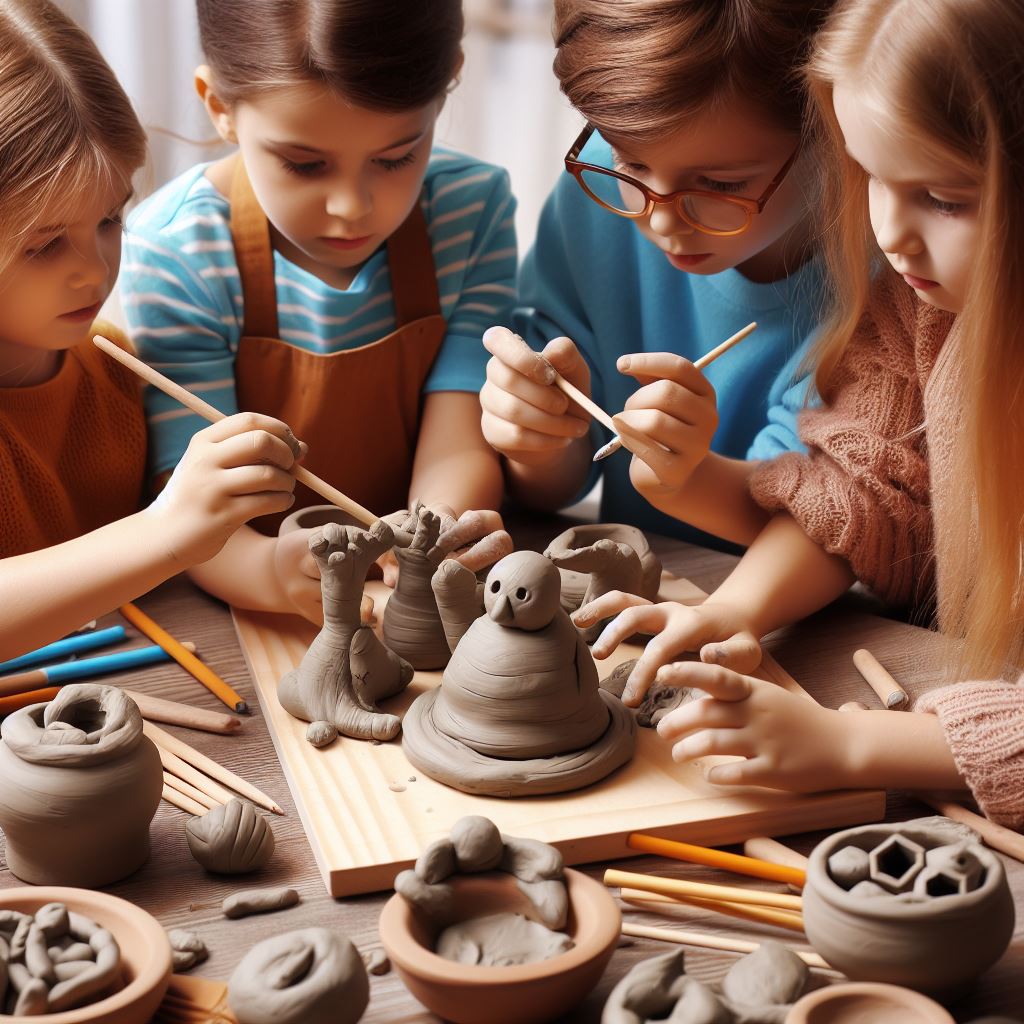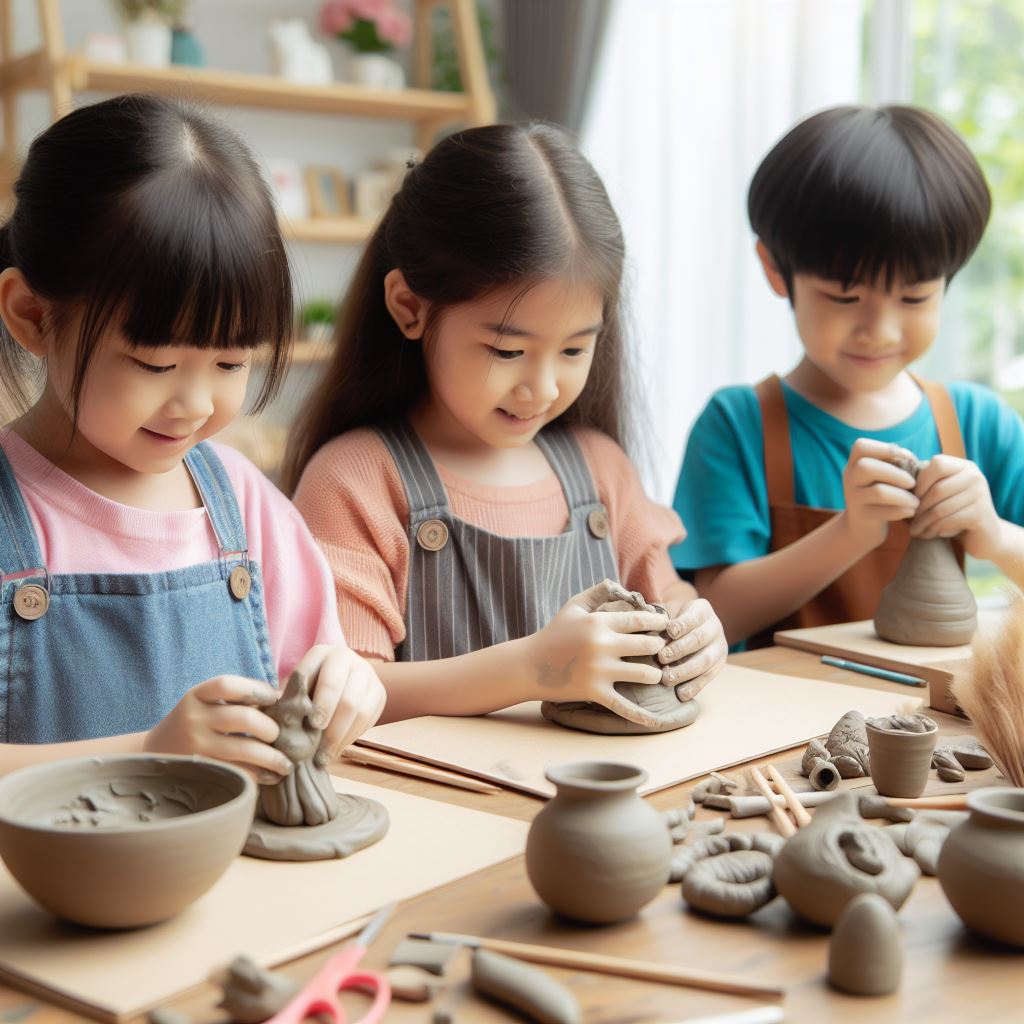Table Of Contents
- 1 Shaping Minds: Sculpting with Clay for Developing Problem-Solving Skills and Critical Thinking in Children
- 1.1 By engaging in open-ended clay sculpting, children are empowered to:
- 1.2 Understanding Problem-Solving Skills and Critical Thinking
- 1.3 Problem-solving skills encompass the ability to:
- 1.4 Critical thinking, on the other hand, involves:
- 1.5 Techniques and Activities for Fostering Problem-Solving and Critical Thinking
- 1.6 1. Open-Ended Challenges:
- 1.7 2. Collaborative Creations:
- 1.8 3. Reflective and Analytical Activities:
- 1.9 4. Playful Experimentation:
- 1.10 Key Takeaways:
- 1.11 FAQs:
- 1.11.1 1. At what age can children start benefiting from clay sculpting for cognitive development?
- 1.11.2 2. What type of clay is best for fostering problem-solving and critical thinking?
- 1.11.3 3. How often should children engage in clay sculpting activities?
- 1.11.4 4. How can I adapt clay sculpting activities to address specific learning challenges in children?
- 1.11.5 5. Where can I find resources and support for incorporating clay sculpting into my child’s routine?
- 1.12 Conclusion:
Shaping Minds: Sculpting with Clay for Developing Problem-Solving Skills and Critical Thinking in Children

In a world that demands adaptability and resourcefulness, nurturing problem-solving skills and critical thinking is crucial for children’s success. While traditional academic pursuits play a vital role, fostering creative exploration through play offers a unique and engaging avenue for intellectual growth.
Sculpting with clay, a seemingly simple activity, transcends the realm of mere artistic expression. It provides a powerful platform for children to develop essential cognitive skills, cultivate critical thinking habits, and become effective problem solvers.
As children manipulate the clay, they engage in a dynamic process of planning, visualizing, and executing their ideas. This hands-on experience encourages them to experiment, explore possibilities, and overcome challenges, all while fostering the development of:
- Problem-Solving Skills: They learn to identify problems, analyze situations, and formulate creative solutions.
- Critical Thinking Skills: They develop analytical thinking, reasoning, and decision-making abilities.
- Planning and Visualization Skills: They learn to plan their creations, visualize outcomes, and adapt their plans as needed.
- Spatial Reasoning Skills: They develop an understanding of spatial relationships and manipulate objects in three-dimensional space.
- Fine Motor Skills: They improve hand-eye coordination, dexterity, and control over their movements.
By engaging in open-ended clay sculpting, children are empowered to:

- Think independently and creatively.
- Approach problems with a flexible and adaptable mindset.
- Develop resilience and persistence in the face of challenges.
- Learn from mistakes and iterate on their ideas.
- Gain confidence in their ability to solve problems and think critically.
This journey through the world of clay sculpting is not only about shaping tangible creations; it’s about shaping young minds to become independent thinkers and effective problem solvers, ready to tackle the challenges and opportunities that lie ahead. In the coming sessions, we will delve deeper into the fascinating world of clay sculpting and explore:
- Specific techniques and activities that promote problem-solving and critical thinking in children.
- The role of open-ended play and creativity in fostering intellectual development.
- Tips for creating a supportive and stimulating environment for clay sculpting activities.
- Real-life examples and case studies highlighting the impact of clay sculpting on children’s cognitive development.
Understanding Problem-Solving Skills and Critical Thinking

Before delving into the practical realm of clay sculpting and its impact on cognitive development, let’s take a moment to clarify the key concepts at the heart of this exploration: problem-solving skills and critical thinking.
Problem-solving skills encompass the ability to:
- Identify and define problems: Recognizing the existence of a problem and clearly understanding its nature is the first step towards finding a solution.
- Analyze situations: Gathering information, considering different perspectives, and understanding the context of the problem are essential for formulating effective solutions.
- Generate creative solutions: Thinking outside the box, exploring diverse possibilities, and coming up with innovative approaches are crucial for overcoming challenges.
- Evaluate and choose solutions: Assessing the feasibility and effectiveness of different solutions allows children to make informed decisions and choose the best course of action.
- Implement solutions and monitor progress: Putting the chosen solution into practice and observing its impact helps children learn from their experiences and refine their problem-solving skills.
Critical thinking, on the other hand, involves:
- Formulating questions: Questioning assumptions, challenging existing ideas, and seeking understanding are fundamental to developing a critical perspective.
- Analyzing information: Evaluating the validity and reliability of information, identifying bias, and drawing logical conclusions are essential for informed decision-making.
- Reasoning and logic: Applying logical reasoning and drawing sound conclusions from available information are crucial for forming well-informed opinions and making responsible choices.
- Thinking independently: Developing one’s own ideas and perspectives, while considering diverse viewpoints, fosters intellectual autonomy and critical thinking skills.
- Reflective thinking: Examining one’s own thinking process, identifying biases, and learning from mistakes are essential for continuous intellectual growth.
By engaging in clay sculpting activities, children have the unique opportunity to develop these essential cognitive skills in a hands-on and engaging way. As they manipulate the clay, they are constantly encountering and overcoming challenges, asking questions, and experimenting with different solutions. This dynamic process fosters both problem-solving and critical thinking, equipping them with valuable tools for navigating the complexities of the world around them.
Techniques and Activities for Fostering Problem-Solving and Critical Thinking

Armed with a clear understanding of the key concepts, let’s dive into the practical world of clay sculpting and explore specific techniques and activities that can effectively foster problem-solving and critical thinking in children.
1. Open-Ended Challenges:
- Mystery Box Challenge: Present children with a box containing various objects and materials. Their challenge is to use the clay to create something using only the materials found in the box. This encourages creativity, problem-solving, and resourcefulness.
- Transformation Challenge: Provide children with a specific object or image. Their task is to transform the object using clay, adding, removing, or altering its shape to create something new. This fosters critical thinking and creative problem-solving.
- “What If” Scenarios: Introduce hypothetical scenarios or problems related to the clay project. Encourage children to brainstorm solutions, analyze potential consequences, and choose the most effective course of action.
2. Collaborative Creations:
- Building Together: Divide a large clay project into individual sections. Each child works on their section while considering how their creation will connect and integrate with the other sections. This promotes teamwork, communication, and problem-solving in a collaborative setting.
- Sculpting a Story: Assign each child a character or element from a story. They then sculpt their assigned part and work together to assemble the story using all the individual creations. This fosters critical thinking, collaboration, and storytelling skills.
- “Find the Error” Activity: Create a clay structure with deliberate errors. Encourage children to observe the structure, identify the errors, and work together to fix them. This promotes critical observation, problem-solving, and communication.
3. Reflective and Analytical Activities:
- “What Went Wrong?” Discussion: After completing a project, encourage children to reflect on the process. Discuss any challenges they faced, mistakes they made, and how they overcame them. This promotes self-awareness, critical thinking, and learning from experiences.
- “What Would You Do Differently?” Activity: After analyzing their creations, encourage children to suggest improvements or modifications. This fosters critical thinking, problem-solving, and a growth mindset.
- “Explain Your Creation” Challenge: Ask children to explain their clay creations, focusing on their thought process, problem-solving strategies, and the message or story their sculpture conveys. This encourages communication, critical thinking, and self-reflection.
4. Playful Experimentation:
- Blind Sculpting Challenge: One child sculpts an object while blindfolded, relying on the instructions and guidance of another child. This fosters communication, problem-solving, and trust.
- Time-Limited Challenges: Set time limits for completing a specific clay project. This encourages quick thinking, resourcefulness, and problem-solving under pressure.
- Mix it Up: Encourage children to experiment by combining different colors, textures, and materials with the clay. This fosters creativity, exploration, and problem-solving in a playful and open-ended environment.
Remember, the key to maximizing the benefits of clay sculpting is to create a supportive and encouraging environment. Encourage open-ended exploration, ask thought-provoking questions, and celebrate creativity and problem-solving efforts. By incorporating these techniques and activities into your child’s routine, you empower them to become effective problem solvers, critical thinkers, and confident individuals ready to tackle any challenge.
As we conclude our journey through the transformative world of clay sculpting and its impact on fostering problem-solving and critical thinking in children, let’s recap the key takeaways and address any lingering questions you may have.
Key Takeaways:
- Modeling clay encourages kids to plan, visualize, and execute their ideas, fostering essential cognitive skills like problem-solving and critical thinking.
- Open-ended clay sculpting challenges and activities provide a dynamic platform for children to develop analytical thinking, reasoning, and decision-making abilities.
- Collaborative creations, “What If” scenarios, and reflective discussions promote communication, critical observation, and the ability to learn from mistakes.
- Playful experimentation with clay encourages quick thinking, resourcefulness, and creative problem-solving under pressure.
FAQs:
1. At what age can children start benefiting from clay sculpting for cognitive development?
Children as young as preschool age can benefit from exploring the tactile properties of clay. As their fine motor skills and cognitive abilities develop, they can engage in more complex sculpting challenges that promote problem-solving and critical thinking.
2. What type of clay is best for fostering problem-solving and critical thinking?
Non-toxic air-drying clay is a safe and versatile option for younger children. Polymer clay offers more durability and flexibility but requires baking in an oven. Ultimately, the best clay choice depends on the specific activities and age of the children.
3. How often should children engage in clay sculpting activities?
Regular engagement is crucial for maximizing the benefits of clay sculpting. Aim for at least one sculpting session per week, incorporating age-appropriate challenges and activities to foster continuous cognitive growth.
4. How can I adapt clay sculpting activities to address specific learning challenges in children?
With guidance from educators or specialists, clay sculpting activities can be adapted to address specific learning challenges. Modifications can involve providing additional support, focusing on specific cognitive skills, and tailoring the challenges to the individual child’s needs.
5. Where can I find resources and support for incorporating clay sculpting into my child’s routine?
Numerous online resources, books, workshops, and art programs provide guidance and inspiration for parents, educators, and caregivers looking to incorporate clay sculpting into children’s lives. Online communities and forums can also offer valuable support and networking opportunities.
Conclusion:
By incorporating the knowledge and tools gained from this exploration, you can empower your child to become a confident problem solver, a critical thinker, and a creative individual ready to shape their own future. Remember, clay sculpting offers a timeless and engaging platform for fostering cognitive development, allowing children to explore their potential and mold their minds into instruments of innovation and ingenuity.
1 thought on “Sculpting With Clay For Developing Problem-Solving Skills And Critical Thinking In Children”